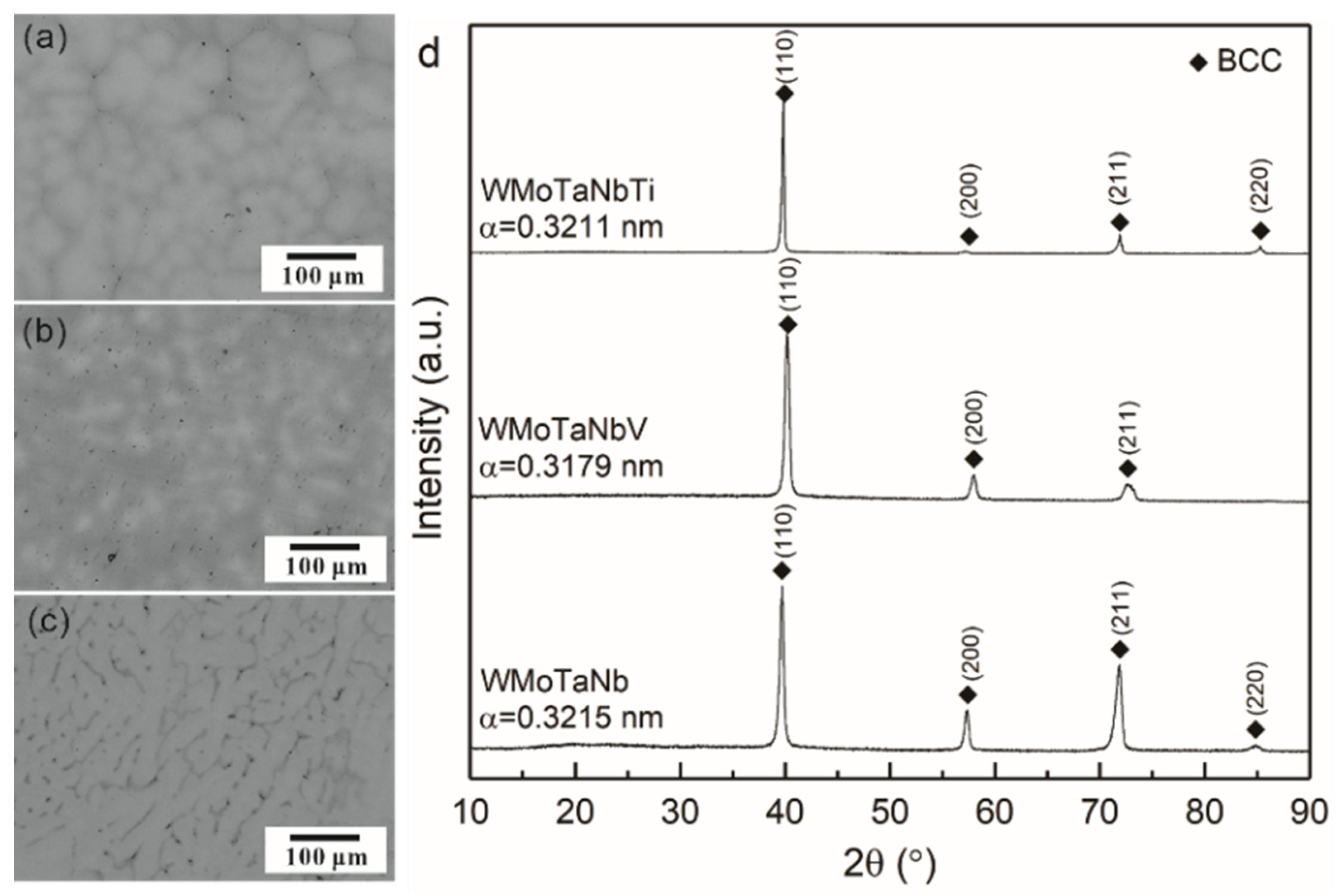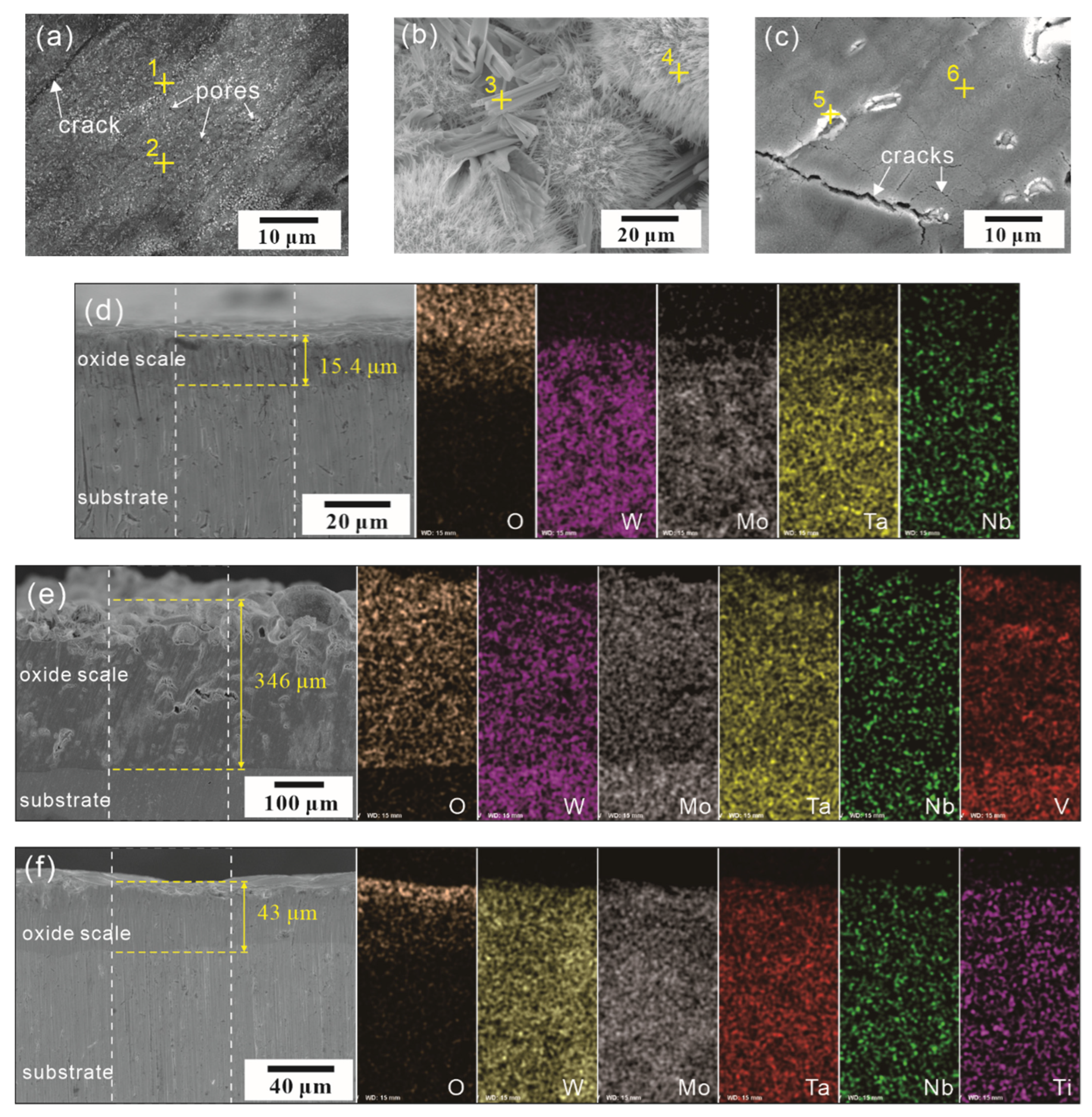Effect of V and Ti on the Oxidation Resistance of WMoTaNb Refractory High-Entropy Alloy at High Temperatures
Abstract
:1. Introduction
2. Materials and Methods
3. Results and Discussion
4. Conclusions
Author Contributions
Funding
Institutional Review Board Statement
Informed Consent Statement
Data Availability Statement
Conflicts of Interest
References
- Lee, C.; Kim, G.; Chou, Y.; Musicó, B.L.; Gao, M.C.; An, K.; Song, G.; Chou, Y.-C.; Keppens, V.; Chen, W.; et al. Temperature dependence of elastic and plastic deformation behavior of a refractory high-entropy alloy. Sci. Adv. 2020, 6, eaaz4748. [Google Scholar] [CrossRef]
- Senkov, O.N.; Miracle, D.B.; Chaput, K.J.; Jean-Philippe, C.J. Development and exploration of refractory high entropy alloys-A review. J. Mater. Res. 2018, 33, 3092–3128. [Google Scholar] [CrossRef] [Green Version]
- Ostovari Moghaddam, A.; Zherebtsov, D.; Shaburova, N.A.; Trofimov, E.A. Single-Phase Medium- to High-Entropy Alloys Developed by a Simple Thermodynamic Approach. JOM 2021, 73, 3430–3438. [Google Scholar] [CrossRef]
- Senkov, O.N.; Wilks, G.B.; Scott, J.M.; Miracle, D.B. Mechanical properties of Nb25Mo25Ta25W25 and V20Nb20Mo20Ta20W20 refractory high entropy alloys. Intermetallics 2011, 19, 698–706. [Google Scholar] [CrossRef]
- Wen, J.; Chu, X.; Cao, Y.; Li, N. Effects of Al on Precipitation Behavior of Ti-Nb-Ta-Zr Refractory High Entropy Alloys. Metals 2021, 11, 514. [Google Scholar] [CrossRef]
- Chen, G.; Xiao, Y.; Ji, X.; Liang, X.; Hu, Y.; Cai, Z.; Liu, J.; Tong, Y. Effects of Zr Content on the Microstructure and Performance of TiMoNbZrx High-Entropy Alloys. Metals 2021, 11, 1315. [Google Scholar] [CrossRef]
- Vellios, N.; Keating, P.; Tsakiropoulos, P. On the Microstructure and Properties of the Nb-23Ti-5Si-5Al-5Hf-5V-2Cr-2Sn (at.%) Silicide-Based Alloy—RM(Nb)IC. Metals 2021, 11, 1868. [Google Scholar] [CrossRef]
- Han, Z.D.; Luan, H.W.; Liu, X.; Chen, N.; Li, X.Y.; Shao, Y.; Yao, K.F. Microstructures and mechanical properties of TixNbMoTaW refractory high-entropy alloys. Mater. Sci. Eng. A 2018, 712, 380–385. [Google Scholar] [CrossRef]
- Luo, G.; Jiang, S.; Kang, K.; Wang, X.; Zhang, J.; Sun, Y.; Shen, Q. Eutectic-like composite of MoNbWTaC with outstanding strength and plasticity at elevated temperature. Mater. Lett. 2021, 304, 130739. [Google Scholar] [CrossRef]
- Xiao, B.; Jia, W.; Tang, H.; Wang, J.; Zhou, L. Microstructure and mechanical properties of WMoTaNbTi refractory high-entropy alloys fabricated by selective electron beam melting. J. Mater. Sci. Technol. 2022, 108, 54–63. [Google Scholar] [CrossRef]
- Fu, T.; Cui, K.; Zhang, Y.; Wang, J.; Shen, F.; Yu, L.; Qie, J.; Zhang, X. Oxidation protection of tungsten alloys for nuclear fusion applications: A comprehensive review. J. Alloys Compd. 2021, 884, 161057. [Google Scholar] [CrossRef]
- Schellert, S.; Gorr, B.; Laube, S.; Kauffmann, A.; Heilmaier, M.; Christ, H.J. Oxidation mechanism of refractory high entropy alloys Ta-Mo-Cr-Ti-Al with varying Ta content. Corros. Sci. 2021, 192, 109861. [Google Scholar] [CrossRef]
- Wegener, T.; Klein, F.; Litnovsky, A.; Rasinski, M.; Brinkmann, J.; Koch, F.; Linsmeier, C. Energy Development of yttrium-containing self-passivating tungsten alloys for future fusion power plants. Nucl. Mater. 2016, 9, 394–398. [Google Scholar]
- Flamini, C.; Ciccioli, A.; Traverso, P.; Gnecco, F.; Giardini Guidoni, A.; Mele, A. Laser-induced evaporation, reactivity and deposition of ZrO2, CeO2, V2O5 and mixed Ce-V oxides. Appl. Surf. Sci. 2000, 168, 104–107. [Google Scholar] [CrossRef]
- Ostovari Moghaddam, A.; Sudarikov, M.; Shaburova, N.; Zherebtsov, D.; Zhivulin, V.; Ashurali Solizoda, I.; Starikov, A.; Veselkov, S.; Samoilova, O.; Trofimov, E. High temperature oxidation resistance of W-containing high entropy alloys. J. Alloys Compd. 2021, 162733. [Google Scholar] [CrossRef]
- Veselkov, S.; Samoilova, O.; Shaburova, N.; Trofimov, E. High-Temperature Oxidation of High-Entropic Alloys: A Review. Materials 2021, 14, 2595. [Google Scholar] [CrossRef] [PubMed]
- Ostovari Moghaddam, A.; Shaburova, N.A.; Sudarikov, M.V.; Veselkov, S.N.; Samoilova, O.V.; Trofimov, E.A. High temperature oxidation resistance of Al0.25CoCrFeNiMn and Al0.45CoCrFeNiSi0.45 high entropy alloys. Vacuum 2021, 192, 110412. [Google Scholar] [CrossRef]
- Li, L.-C.; Li, M.-X.; Liu, M.; Sun, B.-Y.; Wang, C.; Huo, J.-T.; Wang, W.-H.; Liu, Y.-H. Enhanced oxidation resistance of MoTaTiCrAl high entropy alloys by removal of Al. Sci. China Mater. 2021, 64, 223–231. [Google Scholar] [CrossRef]
- Lo, K.-C.; Chang, Y.-J.; Murakami, H.; Yeh, J.-W.; Yeh, A.-C. An oxidation resistant refractory high entropy alloy protected by CrTaO4-based oxide. Sci. Rep. 2019, 9, 7266. [Google Scholar] [CrossRef]
- Gorr, B.; Müller, F.; Schellert, S.; Christ, H.-J.; Chen, H.; Kauffmann, A.; Heilmaier, M. A new strategy to intrinsically protect refractory metal based alloys at ultra high temperatures. Corros. Sci. 2020, 166, 108475. [Google Scholar] [CrossRef]
- Tan, X.Y.; Klein, F.; Litnovsky, A.; Wegener, T.; Schmitz, J.; Linsmeier, C.; Coenen, J.W.; Breuer, U.; Rasinski, M.; Li, P.; et al. Evaluation of the high temperature oxidation of W-Cr-Zr self-passivating alloys. Corros. Sci. 2019, 147, 201–211. [Google Scholar] [CrossRef]
- Morin, F.; Beranger, G.; Lacombe, P. Limits of application for Wagner’s oxidation theory. Oxid. Met. 1972, 4, 51–62. [Google Scholar] [CrossRef]
- Müller, F.; Gorr, B.; Christ, H.-J.; Müller, J.; Butz, B.; Chen, H.; Kauffmann, A.; Heilmaier, M. On the oxidation mechanism of refractory high entropy alloys. Corros. Sci. 2019, 159, 108161. [Google Scholar] [CrossRef]
- Yamaguchi, O.; Mukaida, Y.; Shigeta, H. Preparation of Alkoxy-Derived Tantalum Vanadate. J. Am. Ceram. Soc. 1989, 72, 1914–1917. [Google Scholar] [CrossRef]
- Pilling, N.; Bedworth, R.E. The oxidation of metals at high temperatures. J. Inst. Met. 1923, 29, 529. [Google Scholar]
- Xu, C.; Gao, W. Pilling-Bedworth ratio for oxidation of alloys. Mater. Res. Innov. 2000, 3, 231–235. [Google Scholar] [CrossRef]




| RHEA | W | Mo | Ta | Nb | V | Ti |
|---|---|---|---|---|---|---|
| WMoTaNb | 28.2 | 23.3 | 26.5 | 22.1 | - | - |
| WMoTaNbV | 22.7 | 19.5 | 22.2 | 17.8 | 17.8 | - |
| WMoTaNbTi | 26.4 | 18.0 | 23.4 | 17.1 | - | 15.1 |
| Element | W | Mo | Ta | Nb | V | Ti |
|---|---|---|---|---|---|---|
| Radius (Å) | 1.41 | 1.40 | 1.48 | 1.48 | 1.35 | 1.45 |
| Material | Crystal System | W (g) Mole Weight | ρ (g∙cm−3) | ICSD | PBR |
|---|---|---|---|---|---|
| W | Cubic | 183.9 | 19.25 | 653430 | - |
| Mo | Cubic | 95.94 | 10.2 | 162278 | - |
| Ta | Monoclinic | 180.9 | 16.29 | 96594 | - |
| Nb | Cubic | 92.91 | 8.37 | 170906 | - |
| V | Cubic | 50.94 | 6.11 | 260470 | - |
| Ti | Hexagonal | 47.88 | 4.65 | 99778 | - |
| WO3 | Tetragonal | 231.9 | 6.65 | 89092 | 3.65 |
| MoO3 | Orthorhombic | 143.94 | 4.71 | 166362 | 3.25 |
| Ta2O5 | Tetragonal | 441.8 | 8.17 | 157683 | 2.43 |
| Nb2O5 | Monoclinic | 265.82 | 4.55 | 16605 | 2.63 |
| V2O5 | Monoclinic | 181.88 | 4.16 | 156054 | 2.62 |
| TiO2 | Tetragonal | 79.88 | 4.26 | 165925 | 1.82 |
| Spot | O | W | Mo | Ta | Nb | V | Ti |
|---|---|---|---|---|---|---|---|
| 1 | 89.8 | - | - | 4.3 | 5.9 | - | - |
| 2 | 70.5 | 9.2 | - | 10.4 | 9.9 | - | - |
| 3 | 86.5 | - | - | 11.0 | - | 2.6 | - |
| 4 | 55.0 | 8.9 | 1.5 | 13.7 | 17.5 | 3.3 | - |
| 5 | 86.9 | - | - | 13.1 | - | - | - |
| 6 | 77.7 | 8.5 | - | 7.2 | 6.6 | - | - |
Publisher’s Note: MDPI stays neutral with regard to jurisdictional claims in published maps and institutional affiliations. |
© 2021 by the authors. Licensee MDPI, Basel, Switzerland. This article is an open access article distributed under the terms and conditions of the Creative Commons Attribution (CC BY) license (https://creativecommons.org/licenses/by/4.0/).
Share and Cite
Lu, S.; Li, X.; Liang, X.; Yang, W.; Chen, J. Effect of V and Ti on the Oxidation Resistance of WMoTaNb Refractory High-Entropy Alloy at High Temperatures. Metals 2022, 12, 41. https://doi.org/10.3390/met12010041
Lu S, Li X, Liang X, Yang W, Chen J. Effect of V and Ti on the Oxidation Resistance of WMoTaNb Refractory High-Entropy Alloy at High Temperatures. Metals. 2022; 12(1):41. https://doi.org/10.3390/met12010041
Chicago/Turabian StyleLu, Shuaidan, Xiaoxiao Li, Xiaoyu Liang, Wei Yang, and Jian Chen. 2022. "Effect of V and Ti on the Oxidation Resistance of WMoTaNb Refractory High-Entropy Alloy at High Temperatures" Metals 12, no. 1: 41. https://doi.org/10.3390/met12010041
APA StyleLu, S., Li, X., Liang, X., Yang, W., & Chen, J. (2022). Effect of V and Ti on the Oxidation Resistance of WMoTaNb Refractory High-Entropy Alloy at High Temperatures. Metals, 12(1), 41. https://doi.org/10.3390/met12010041






